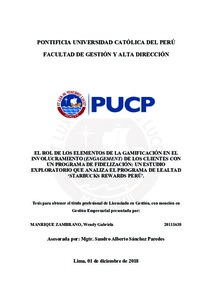| dc.contributor.advisor | Rohner Stornaiuolo, Fred Werner | |
| dc.contributor.author | Gomez Boluarte, Daniel Felwig | |
| dc.date.accessioned | 2020-11-12T00:13:22Z | |
| dc.date.available | 2020-11-12T00:13:22Z | |
| dc.date.created | 2020 | |
| dc.date.issued | 2020-11-11 | |
| dc.identifier.uri | http://hdl.handle.net/20.500.12404/17495 | |
| dc.description.abstract | Las canciones dirigidas al infante son un género musical que aparece en la música de diversos
grupos humanos. Dentro de este grupo podemos reconocer canciones dedicadas al juego, al
aprendizaje, al sueño, así como a la muerte y los funerales. Es en este género en donde también
encontramos a las canciones de cuna. Estas son un tipo de canciones, emitidas por los adultos
hacia los bebes y niños, con el fin de conseguir la relajación y el sueño. A su vez, cargan con
información cultural relacionada a las concepciones de bienestar, salud, roles, concepciones
sociales. Existen propuestas, relacionadas a lo sicológico y al lenguaje, que sugieren que estos
cantos generan esta reacción positiva en los niños al configurar, estos mismos cantos, un código
de lenguaje que resulta atractivo para ellos. Es decir, que contienen características efectivas
para su comunicación. La propuesta de la presente investigación sostiene que estas
características de comunicación, adaptadas para el lenguaje de los niños, no son aquellas
pertenecientes al área de lo narrativo o lo temático de las canciones. Sino que, en vista de que
los bebes o niños no son aún seres con un dominio completo del idioma (sus palabras y/o
significados), las canciones encuentran el elemento efectivo de comunicación en el otro
lenguaje presente: la música. Serán entonces estos caracteres musicales, relacionados a su
composición e interpretación, los que configurarán la eficacia del repertorio y su empleo. Para
ello, la presente investigación trabajará el fenómeno de las canciones de cuna dentro de un
panorama musical cuya comunidad académica, no ha abordado el estudio de las canciones: el
panorama musical peruano, en específico, el panorama musical andino. Para ello, se trabajará
con los migrantes de Apurímac en Lima con quienes se realizarán entrevistas y recopilaciones
de estas canciones, sobre las cuales se realizarán análisis de corte musical sobre características
y parámetros también musicales que aparecen asociadas en las canciones de cuna registradas. | es_ES |
| dc.description.abstract | The infant-directed songs are a musical genre that appears in many human societies. Among
this group we can find songs dedicated to play, to learn, to sleep, and even also to death and
funeral moments. Is in this genre where we also find the lullabies. These are a type of songs,
sung by adults to babies and children, that intend to achieve relaxation and sleep. Within them,
they also carry cultural information related to wellbeing concepts, health, roles in society and
social concepts. There are proposals, related to psychology and language, that suggest that
these songs generate this positive reaction on children as they use language codes that are in
itself attractive to the children. This means that, they have effective characteristics for their
communication and purposes. The proposal of this investigation holds that this communication
characteristics, adapted for the language of the children, are not ones among the areas of the
narrative, lyrics or narrative topics of the songs. Instead, having account that the babies or
infants are not yet fully capable of all the idiom elements (like its words and meanings), the
songs acquire their effective communication element on the other language present: the music.
These musical characteristics, related to the songs composition and performance, will be then
the ones that will generate the effectiveness of the repertoire and its use. For these purposes,
the current investigation will study the subject of the lullabies inside a musical universe that
has not engaged the study of the songs: the Peruvian musical universe, in specific, the Peruvian
Andean musical universe. For that, we will work with the Apurimac’ migrants in Lima with
whom the investigation will perform interviews and cumpilations of these songs, from which
later, musical analysis about the characteristics and musical parameters that appear in the
registered lullabies will be performed. | es_ES |
| dc.language.iso | spa | es_ES |
| dc.publisher | Pontificia Universidad Católica del Perú | es_ES |
| dc.rights | info:eu-repo/semantics/openAccess | es_ES |
| dc.rights.uri | http://creativecommons.org/licenses/by-nc/2.5/pe/ | * |
| dc.subject | Música--Estudio y enseñanza--Estudio de casos | es_ES |
| dc.subject | Canciones infantiles--Perú--Apurímac--Estudio de casos | es_ES |
| dc.subject | Música andina--Perú--Apurímac--Estudio de casos | es_ES |
| dc.title | Las canciones de cuna en el universo musical andino. Un estudio de caso sobre los factores musicales asociados a este tipo de canciones que las unifican en el repertorio | es_ES |
| dc.type | info:eu-repo/semantics/bachelorThesis | es_ES |
| thesis.degree.name | Licenciado en Música | es_ES |
| thesis.degree.level | Título Profesional | es_ES |
| thesis.degree.grantor | Pontificia Universidad Católica del Perú. Facultad de Artes Escénicas | es_ES |
| thesis.degree.discipline | Música | es_ES |
| renati.discipline | 215426 | es_ES |
| renati.level | https://purl.org/pe-repo/renati/level#tituloProfesional | es_ES |
| renati.type | http://purl.org/pe-repo/renati/type#tesis | es_ES |
| dc.publisher.country | PE | es_ES |
| dc.subject.ocde | https://purl.org/pe-repo/ocde/ford#6.04.04 | es_ES |








